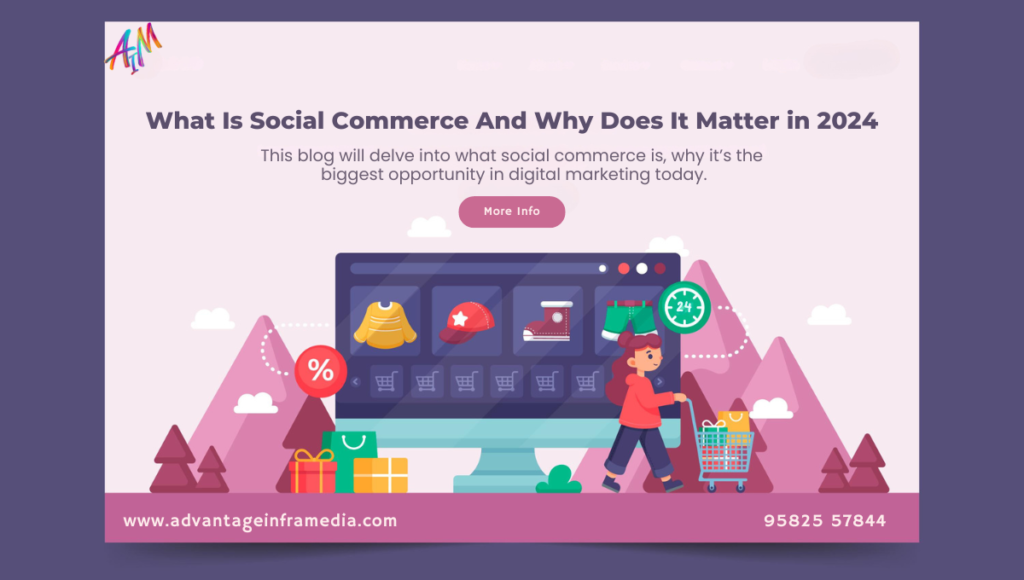In the ever-evolving digital marketing landscape, social commerce has emerged as a significant player. Combining social media with e-commerce, this powerful trend is transforming how consumers discover, shop, and interact with brands. The fusion of shopping and social engagement creates a seamless, interactive experience, which has proven to be more engaging and effective than traditional e-commerce. As more consumers spend time on social media platforms, businesses are leveraging this opportunity to sell directly through these platforms. This blog will delve into what social commerce is, why it’s the biggest opportunity in digital marketing today, and how businesses can successfully harness its power.
Understanding Social Commerce
Definition of Social Commerce
Social commerce is the process of selling products and services directly through social media platforms. Unlike traditional e-commerce where customers are redirected to an external website to complete their purchase, social commerce allows customers to browse, engage, and buy products without ever leaving the social media platform. By integrating the entire shopping experience within social media, social commerce simplifies the buyer’s journey and reduces friction points, which increases conversion rates.
Difference Between Social Commerce and E-Commerce
While e-commerce is the broader term for online shopping via websites and apps, social commerce takes place specifically within social media networks. Traditional e-commerce often relies on a more linear sales funnel — from discovery, to website visit, to checkout — while social commerce shortens this journey by combining discovery, decision-making, and purchasing into one cohesive experience.
The Growth of Social Commerce
Historical Background
Social commerce is not a new concept, but it has only recently gained widespread traction. Initially, social media platforms served primarily as a place for interaction, content sharing, and brand discovery. Over time, businesses saw the value in advertising on these platforms, and eventually, features like “Buy Now” buttons and integrated shopping tabs were introduced. The true acceleration of social commerce, however, came with the rise of mobile shopping and consumers’ increasing comfort with making purchases directly through social platforms.
Rise of Mobile Shopping
The proliferation of smartphones has changed consumer behavior. People now spend a significant portion of their online time on mobile devices, particularly on social media. As a result, mobile-friendly social commerce has become a natural evolution. Shopping via social media on mobile devices offers instant access to products and streamlined payment options, leading to impulse buys and immediate gratification.
Impact of Social Media Platforms
The largest social media platforms, such as Facebook, Instagram, TikTok, and Pinterest, have embraced social commerce by launching various shopping features. These platforms have integrated product catalogs, in-app purchasing, and influencer collaborations to create a seamless shopping experience. This convergence of social media and e-commerce offers a unique opportunity for brands to connect with their audience in ways that traditional e-commerce cannot match.
Why Social Commerce is the Biggest Opportunity in Digital Marketing
Social commerce isn’t just a passing trend; it’s an evolution in consumer behavior and digital marketing strategy. There are several reasons why it stands out as the biggest opportunity in today’s digital landscape.
Personalized Shopping Experience
In the world of digital marketing, personalization is everything. Social commerce offers unprecedented levels of personalization that can be tailored to individual users. Social media platforms are powered by algorithms that know more about their users than any other platform. They track likes, dislikes, shares, and interactions, allowing brands to show highly relevant and personalized products to their target audience. This data helps businesses refine their offerings, enabling them to target the right customers at the right time with the right message.
For example, Facebook Shops can recommend products based on a user’s past interactions, interests, and even purchases made by their friends. This creates a highly personalized shopping experience, which not only improves customer satisfaction but also boosts conversion rates. In traditional e-commerce, personalization can be achieved, but it’s often limited to what happens on a brand’s website. Social commerce takes this to the next level by personalizing the entire shopping experience based on a user’s behavior across social networks.
Social Proof as a Selling Point
Another reason why social commerce is such a big opportunity is the ease of social proof integration. Social proof, which includes customer reviews, testimonials, and user-generated content, is a powerful driver of purchasing decisions. Social media platforms are inherently social, which means they’re naturally suited for sharing recommendations, reviews, and user-generated content.
When users see their peers purchasing and reviewing products, they are more likely to trust the brand and make a purchase themselves. Platforms like Instagram, TikTok, and Pinterest make it easy for users to share their purchases or experiences, which serves as authentic endorsements. Brands can then showcase this user-generated content in their social commerce strategy to build trust and credibility.
For example, when someone buys a product from a brand on Instagram, they can share their purchase in a story or a post, tagging the brand and potentially reaching thousands of people within their social circle. This kind of social proof can be far more persuasive than traditional advertising.
Instant Feedback Loop
One of the challenges with traditional e-commerce is that brands often don’t get immediate feedback on their products or marketing efforts. However, with social commerce, brands can receive real-time feedback from users. This feedback loop allows them to refine their messaging, tweak product offerings, and respond to customer concerns almost instantaneously.
For instance, if a brand posts a shoppable product on Instagram and it doesn’t receive the engagement or sales they anticipated, they can immediately gauge user responses through comments, likes, and direct messages. Based on this feedback, they can adjust their strategy, offer discounts, or promote different features of the product to increase appeal. This ability to test, learn, and iterate rapidly is one of the key advantages of social commerce.
Storytelling Through Shopping
Social media is built around storytelling, and social commerce allows brands to weave shopping into their narrative in an organic and compelling way. Instead of traditional ads that disrupt the user experience, brands can create shoppable content that aligns with the user’s desire for engagement and entertainment.
Take Instagram Stories or TikTok videos, for example. Brands can showcase their products in short, engaging videos where the focus is on storytelling rather than a hard sales pitch. Influencers and brands can seamlessly integrate product recommendations into their content without detracting from the experience. This creates an emotional connection with the audience, which is much more powerful than a simple product listing on an e-commerce website.
Popular Platforms for Social Commerce
While we briefly touched on the top social commerce platforms, it’s worth exploring each in more detail to understand how businesses can maximize their opportunities on these platforms.
Facebook and Instagram Shops
Facebook Shops and Instagram Shops represent one of the most robust and flexible social commerce platforms available today. Businesses of all sizes can set up a shop within Facebook or Instagram, upload their product catalog, and customize their shop’s appearance to match their brand identity. The best part? Customers can discover products through ads, organic posts, stories, or direct searches, and complete their purchases without ever leaving the app.
Facebook and Instagram also allow businesses to tag products directly in their posts, stories, and even in comments, making it easy for users to find and purchase items they’re interested in. The platform integrates seamlessly with popular e-commerce providers like Shopify and BigCommerce, streamlining the entire process.
In addition to shoppable posts and stories, Instagram also has the “Explore” tab, which offers a personalized feed of posts, including shoppable content tailored to the user’s interests. This algorithm-driven discovery process can expose users to products they may not have found otherwise.
With Instagram’s focus on visual content, it’s important for brands to create aesthetically pleasing and engaging visuals that stand out. Instagram’s 2024 updates include a deeper integration of AR and AI tools that enable users to virtually try on products, creating a more immersive shopping experience.
Pinterest Shopping
Pinterest is often viewed as a platform for discovering inspiration, from home décor to fashion, but it’s also becoming a growing player in the social commerce space. Pinterest Shopping enables businesses to tag products in Pins, turning these visual ideas into actionable shopping experiences.
Unlike other social media platforms, Pinterest users are often looking for products and services, making them more likely to purchase. This is an important distinction that brands should take advantage of. Pinterest’s visual search capabilities are another unique feature that sets it apart from other platforms. Users can take a picture of an item they like, and Pinterest will suggest similar products from its database.
In 2024, Pinterest is expanding its shoppable ad formats, making it easier for brands to showcase their product catalog to users. Additionally, Pinterest is integrating more advanced analytics tools that help businesses track the performance of their shoppable Pins, allowing them to optimize for conversions.
TikTok Shopping
TikTok’s explosive growth has been driven by short, viral videos that appeal to younger audiences. In response to its popularity, TikTok introduced TikTok Shopping, a feature that allows businesses to create shoppable videos and product catalogs directly on the platform.
TikTok Shopping is highly integrated with e-commerce providers like Shopify, making it easy for brands to set up their stores and create shoppable content. One of the unique aspects of TikTok Shopping is its reliance on trends and virality. Products can go viral overnight, thanks to TikTok’s algorithm that pushes trending content to a wider audience.
This makes TikTok a prime platform for brands looking to reach Gen Z and millennial shoppers. TikTok’s “Shop Now” button is prominently displayed in videos, enabling users to make purchases with just a few taps. Additionally, TikTok has partnered with influencers and creators to make it easy for them to recommend products, driving social proof and sales simultaneously.
YouTube Shopping
While primarily known as a video-sharing platform, YouTube has gradually expanded its role in social commerce by introducing features like product tagging in videos and direct shopping links. YouTube is ideal for product reviews, unboxing videos, and how-to guides, making it a great platform for brands selling tech gadgets, beauty products, and even home appliances.
YouTube’s integration with Google Shopping further enhances its e-commerce capabilities. Brands can create shoppable ads that appear during or after their videos, allowing viewers to click through and purchase the featured products. YouTube’s focus on longer-form content also gives brands the opportunity to provide more in-depth information about their products, which can help build trust with viewers.
In 2024, YouTube is focusing heavily on integrating live shopping features into its platform. Much like Instagram and Facebook, YouTube will allow brands to host live events where they can showcase their products in real-time, offering exclusive discounts and answering questions directly from viewers.
Social Commerce Trends in 2024
Live Shopping
Live shopping, which combines real-time streaming with e-commerce, is gaining popularity across platforms like Instagram, Facebook, and TikTok. Brands and influencers host live events where they showcase products, answer questions, and offer exclusive deals. This interactive experience drives high engagement and encourages spontaneous purchases.
Augmented Reality (AR) Shopping
AR shopping is becoming more common, allowing users to virtually try on products before buying. From makeup to clothing, AR helps reduce uncertainty and returns by giving customers a better idea of how products will look in real life. This trend is especially popular on Instagram and Snapchat.
Social Media Payment Options
The integration of secure payment options directly into social media platforms is simplifying the checkout process. Facebook Pay, Instagram Checkout, and TikTok’s in-app purchases are examples of how platforms are streamlining transactions to keep users engaged and minimize friction.
How Businesses Can Succeed in Social Commerce
Building a Community
A key element of social commerce success is building a community around your brand. Social media is inherently about community and connection, and businesses that cultivate a loyal following will have a better chance of succeeding in social commerce.
Brands should focus on creating content that resonates with their audience, encouraging discussions, and fostering relationships with their followers. This can include hosting live events, creating user-generated content campaigns, or launching exclusive product drops for followers.
Offering Exclusive Social Media Promotions
One way to incentivize users to engage in social commerce is by offering exclusive promotions or discounts that are only available on social media. Whether it’s a special discount for Instagram followers or an exclusive offer for TikTok users, these promotions encourage users to follow your brand on social platforms and make purchases through your social commerce channels.
This tactic can create a sense of urgency, driving impulse buys and increasing engagement. By offering time-sensitive promotions, businesses can take advantage of social media’s instant nature to drive immediate sales.
Monitoring Analytics and Performance
Social commerce platforms come equipped with a variety of analytics tools that provide businesses with valuable insights into customer behavior, engagement rates, and sales performance. Brands must continuously monitor their analytics to understand what’s working and what isn’t. Metrics such as engagement rates, click-through rates, and conversion rates should be tracked regularly.
By analyzing these data points, businesses can optimize their strategies, test different content formats, and adjust their campaigns to maximize performance. Social commerce is highly dynamic, and success comes from constant experimentation and iteration.
Challenges of Social Commerce
Security and Privacy Concerns
As with any online transaction, social commerce raises concerns about security and privacy. Consumers need to feel confident that their payment information is secure, and brands must comply with data protection regulations to ensure customer trust.
Balancing Personalization with Data Privacy
While personalization is key to social commerce success, it can also raise privacy concerns. Striking a balance between creating personalized shopping experiences and respecting user privacy is crucial for building long-term relationships with customers.
Competition and Saturation
With so many brands turning to social commerce, the space is becoming increasingly competitive. Businesses need to differentiate themselves through unique content, exceptional customer service, and innovative strategies to stand out from the crowd.
Case Studies: Brands Succeeding in Social Commerce
Here, we’ll look at some real-world examples of brands that have excelled in social commerce, highlighting their strategies and success stories.
Conclusion
Social commerce represents the next frontier in digital marketing, offering brands unprecedented opportunities to connect with consumers, build relationships, and drive sales. As social media platforms continue to evolve and integrate more shopping features, businesses that embrace social commerce will be able to tap into new revenue streams and engage with their audiences in more meaningful ways.
For businesses, the key to succeeding in social commerce lies in understanding the unique strengths of each platform, creating personalized and engaging content, and leveraging social proof to build trust with potential buyers. By focusing on these strategies, brands can turn social media into a powerful sales channel and capitalize on the biggest opportunity in digital marketing today.




